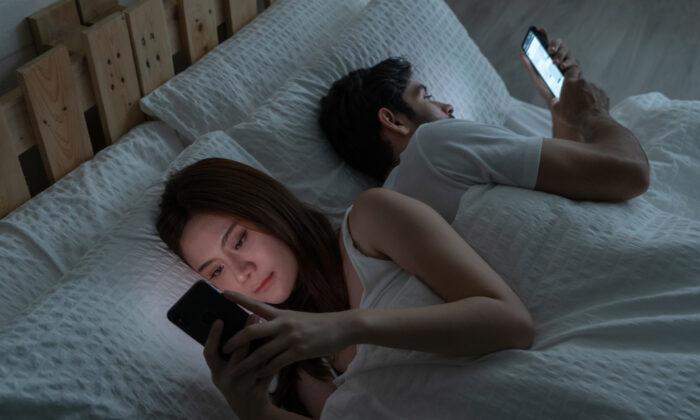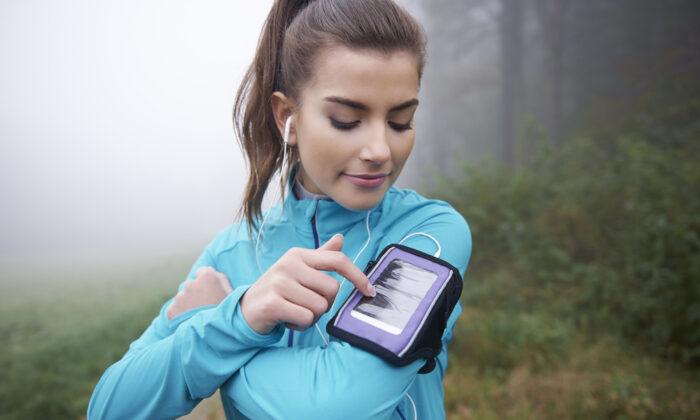Picture this: Your alarm goes off in the morning, and you wake up to start your day. Before getting out of bed, you check all of the notifications on your phone. Maybe you do some morning yoga or go on a walk. While you’re making breakfast or waiting for your morning coffee, you scroll through all your social media apps to pass some time. At work, you go throughout your day staring at your computer screen. Even meetings now are virtual. You go to the gym, working out to your favorite music on your phone, or you do an at-home streaming workout class. You cook a healthy dinner and then turn on the TV to watch your favorite Netflix show. Right before bed, you scroll through your social media apps one last time before finally hitting the hay.
If this is very easy for you to picture, we don’t blame you!
Even when prioritizing mental health, spiritual health, physical health, and nutritional health, your holistic wellness can suffer due to a pillar of health that is just now starting to make a name for itself, as it becomes more and more a part of our daily lifestyle: Digital Health.
Technology in Our Daily Lives
In today’s world, nearly everyone has a smartphone, laptop, or some form of digital technology that they use every day, and for many people, technology consumes the majority of their time awake. Technology is so ingrained into our everyday life that we probably don’t even realize the impact it has on our mental and physical health.However, in recent years, many doctors, scientists, and health and wellness gurus have begun to speak out about the harmful effects that can come from having an unhealthy relationship with our devices and the ways we spend our time using them. Health practitioners have been able to identify technology as a root cause for many health complaints, and are prescribing ways for patients to moderate their tech use or use it in a healthier way.
DefenderShield has partnered with holistic health practitioners and clinics, home consultants, and more from all around the world. These include holistic treatment facilities like Dr. EMF and the Epigenetics Healing Center. These are highly knowledgeable doctors and medical experts that recognize the effects a digital lifestyle has on people, and what people can do to combat these digital wellness health impacts. From California, to British Columbia, to Australia, you can check out our partners page if you are interested in finding out more.
What Does Digital Wellness Mean, and Why is it Becoming a Top Health Trend in 2022?
Digital wellness can be defined as a way of life, while using technology, that one pursues in order to create a healthy and intentional relationship between yourself and your technology both at home and at work.We see it as consuming technology in a safe, healthy, and sustainable way.
As the digital age that we live in today continues to grow and evolve, there are more people using technology than ever before.
Technology usage during the global COVID-19 pandemic in 2020 was extremely beneficial to those working from home, online schooling, and staying connected to family and loved ones.
The pandemic saw a huge surge of remote working, forcing people to work on their laptops at home. For a lot of people, this also meant working overtime. School was forced online for many, with 8+ hours a day of online classes and homework. On top of this, a global shutdown meant more young children and adults began spending hours a day on social media platforms such as Instagram and TikTok. In fact, the number of users on TikTok in 2020 grew by 85.3%.
COVID shutdowns and remote work needs, the natural evolution of technology, and the rollout of 5G and its goal to connect everything to the IOT, all created the perfect storm for technology to be used–and abused. The effects of this are creating a wellness revolution surrounding the way we use our devices.
Who is at Risk of Digital Un-Wellness?
Nowadays, most people are spending a majority of their day consuming technology. There is no escaping a digital lifestyle, whether it’s during work, school, or for entertainment.That being said, although anyone can experience negative health effects from too much technology use, the youth fall most vulnerable.
Not only do they tend to spend the most time on technology, and will spend the highest percentage of their lives with technology, but childrens’ bodies are still developing and are more likely to have both harmful physical and behavioral problems that result from too much exposure to their devices.
In fact, a study done by the American Academy of Pediatrics examined the impact of technology on psychological issues, behavioral problems, attention problems, and physical health among kids. The study found more technology use predicted ill-being for all ages, even after factoring out certain variables such as junk food and exercise.
In August 2021, the Federal Communications Commission (FCC) lost a court case to the Children’s Health Defense (CHD) showing that 5G and wireless radiation standards fail to adequately protect the public, and children, from the harmful effects of EMF Radiation coming from our electronic devices. Shortly after, the Environmental Working Group (EWG) introduced the first set of standards for children, where they recommend up to 200-400 times lower than the FCC’s suggested limit of 1.6 watts per kilogram.
Aspects of Poor Digital Health, and the Impact it Can Have on Your Mental and Physical Wellbeing
Unhealthy digital wellness practices apply to everyone, and can come in a variety of forms. For some, unhealthy digital consumption may look like endlessly scrolling through social media, not taking breaks away from your computer at work, or even exposing yourself to unnecessary EMF radiation by working with your laptop on your lap or keeping your phone in your bra or under your pillow.If people don’t become mindful of their technology consumption, many mental and physical health issues may be impacted.
EMF Exposure & 5G
In 2019 the nationwide rollout of 5G–the newest cellular network–began, and is now currently heavily underway. Although 5G will undoubtedly make life more convenient for all, public health and safety concerns including multiple health concerns come from EMF radiation exposure.Electromagnetic radiation (EMFs), are energy frequencies emitted by electronic devices such as our laptops, computers, WiFi routers, etc. Chronic exposure to EMF can impact our bodies on a biological level and lead to many health effects. 5G frequencies are the highest frequencies yet, and come with their own health concerns–physical, and mental.
- Sleep Issues: EMF and Blue Light have both been proven to delay the release of melatonin in your brain. Poor sleep quality can lead to a laundry list of conditions, as well as poor mental health.
- Fertility Issues: Fertility issues in both men and women have been proven in hundreds of studies to lower sperm count and motility in men, as well as cause oxidative stress in cells, which can damage sperm DNA as well as damage other reproductive organs and tissues, ultimately disrupting both male and female fertility rates.
- Skin Conditions: The thermal effects of EMFs can cause burns, skin rashes, and Toasted Skin Syndrome which can permanently damage the skin. With 5G, one study revealed that waves over 60GHz (5G), penetrated the skin by 90%.
- Cell Damage and Mutation: EMFs are considered a man-made environmental toxin. Certain toxins can lead to cell damage/mutation. The WHO/International Agency for Research on Cancer (IARC) has classified radio frequency electromagnetic fields as possibly carcinogenic to humans based on an increased risk of glioma, and malignant brain cancer, associated with wireless phone use.
On the other side of EMF exposure from your technology is a decline in your mental health. Surprisingly enough, Instagram may not be the only aspect of your phone that contributes to a higher risk of anxiety, depression, and other mental health issues.
A 2018 cross-sectional study found that depression and sleep quality were significantly worse in a group of workers exposed to high levels of EMF, compared to a group of workers who were not exposed.
Studies have also begun to show that EMFs can affect brain health and functionality. It was found in a 2019 study that EMF exposure can induce changes in the central nervous system’s nerve cells, and can act as a stress source in living creatures.
Another study found that acute exposure to cell phones has an effect on metabolic activity in the human brain, with increases in glucose metabolism found in the side of the brain where a cell phone was held against.
Blue Light Exposure
Blue light comes from high energy blue wavelengths that are primarily beneficial when they come from the sun during daylight hours. They are able to boost attention, reaction times and moods, all while keeping us awake. However, too much blue light–especially at night when this light throws the body’s circadian rhythm out of whack–can become disruptive to our health and impede sleep.Because the digital age that we live in today has progressed our screen time to being almost constant, our exposure to blue light has heavily increased. This increased exposure to blue light–even during the daylight hours–can lead to a number of health effects, including: eye strain, eye fatigue, headaches, focus issues, trouble going to sleep, lack of quality REM sleep, and may contribute to the causation of obesity, diabetes, heart disease, and even cancer.
Blue light glasses are among the first of the solutions that are on the rise towards better digital wellness practices, and becoming more mainstream everyday. Wearing blue light glasses is a great first step in reducing your risk of blue light exposure, and alleviating eye strain.
Technology Addiction and Social Health
One of the most common aspects of poor digital wellness is tech addiction and social health. Since the emergence of smartphones, laptops, tablets, etc., research has shown a major increase in the number of people becoming addicted to technology. Tech addiction operates in a similar fashion to chemical addictions–an expected ‘reward’ when using things like social media for likes on a photo, video games for wins, etc., can release dopamine in the brain, and eventually you will begin to crave the attention or rewards coming from your tech usage.On top of this, social health has been at an all time decline. A lot of people will spend more time on their technology than they will having face-to-face conversations, which can ultimately lead to poor social and communication skills.
An increased use of technology, specifically social media, has also contributed to a rise in tech addiction and mental health issues. In fact, nearly 1 in 5 adults in the United States suffer from a mental health condition. There’s a lot of different ways that being digitally unhealthy can impact your mental health. Both social media and EMF exposure can independently contribute to things like anxiety, depression, lack of quality sleep, and a lack of focus and memory issues.
According to the Pew Research Center, 69% of adults and 81% of teens in the U.S. use social media. This puts a large amount of the population at an increased risk of feeling anxious, depressed, or ill over their social media use. Why? Researchers have found that after only one hour of screen time per day, smartphone users had less curiosity, more distractibility, more difficulty making friends, and were more difficult to care for. They also had lower self-control and less emotional stability–leading to higher depression rates.

Posture
Research has shown that the average adult checks their phone between 50-300 times per day, and teens almost triple that. Our heads weigh 10-14 pounds, and for every inch our head is bent down, the stress on our neck and upper back doubles, leading to negative effects on our physical structure.Sitting in front of your office computer screen for hours at a time can also strain both your neck and back. Instead of keeping your torso stacked up straight at your desk, you are leaning forward to look at your screen, or slouching back.
Technology usage reduces your need to stand up or walk around, and can lead to hours sitting at a desk, looking down at your phone, or curling up on the couch. With physical activity being a main pillar of health, this is cause for concern. And while you may think your 1 hour of exercise makes up for your lack of movement throughout the day, you may still experience chronic pain if you aren’t prioritizing good posture and consistent movement, a key aspect of digital wellness.
Ways to Prioritize Digital Wellness at Work and Home
- Be intentional with your screen time, and limit screen time for your children
- Get off technology 2 hours before bed. This will reduce the effects of EMF exposure, putting your body in the best possible state for a good night’s sleep, and no technology means no energizing blue light to mess up your melatonin production schedule.
- Create a Tech Free Zone. An EMF-free sanctuary without technology can be of enormous benefit for your sleep, your meditation, or if you are just trying to focus on a task without distractions. Try not to put your WFH office in your bedroom, and if it is, turn off and unplug everything before going to bed.
- Turn your WiFi router off at night, or whenever you aren’t using it. WiFi routers emit EMF frequencies at a higher power level than your phone, so they can travel farther. A Christmas-tree timer is a great solution to having it turn off every night when you aren’t using it!
- Take breaks at work by stepping away from technology every few hours. Trying walking outside (grounding is great for filling your body with GOOD frequencies!). And no, a lunch break doesn’t count as a break if you are just mindlessly scrolling through your phone.
- Use a standing desk or a chair that helps with posture alignment during work. Keep your body moving, even if it’s just some calf raises or back stretches, to stay alert and focused.
- Mute your notifications to help with focusing on tasks. Better yet…
- Turn your phone on airplane mode, especially at night, or turn it off completely to reduce EMF emissions and avoid distractions.
- Get an app or enable time limit settings on your social media accounts or just on your phone in general to become more mindful of how long you spend on your mobile device. This will hopefully reduce chances of technology addiction while reducing your daily EMF and blue light exposure.
- Wear Blue Light Glasses to alleviate eye strain at work and at home. If you do use technology at night, wear 99% blue light blocking glasses to reduce the effects of delayed melatonin production and insomnia.
- Use EMF shielding technology such as EMF radiation blocking laptop shields and phone cases that put a physical shielding barrier in between an EMF-emitting device and your body, to protect vulnerable organs in your body (brain, heart, reproductive organs, skin) from direct contact with EMF emissions.






Friends Read Free